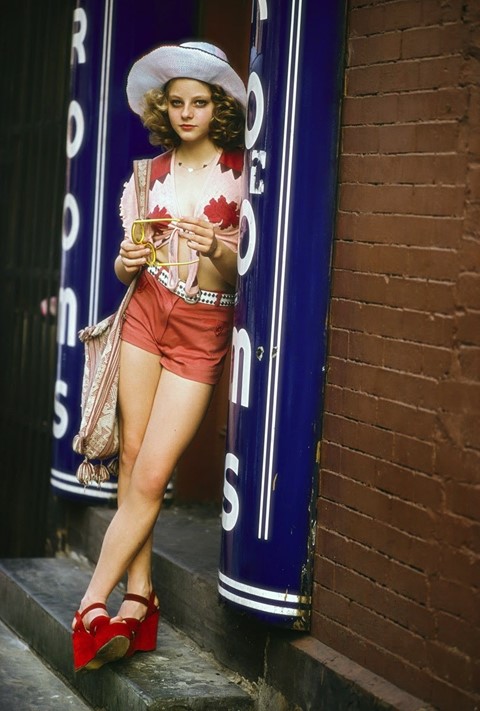As Martin Scorsese’s 70s masterpiece returns to the silver screen, we decode the wardrobe of Jodie Foster’s iconic character
Last year marked the 40th anniversary of Martin Scorsese’s 1976 masterpiece Taxi Driver, a hypnotising parable of disenfranchisement in the dirt and crime-riddled streets of 70s New York. This month offers UK viewers the chance to see the film on the big screen as part of the BFI’s current season dedicated to the inimitable director. The keys to Taxi Driver’s success are myriad, from the masterful direction and brooding cinematography to Bernard Herrmann’s moody jazz score, the claustrophobic script by Paul Schrader and Robert De Niro’s searing performance as Travis Bickle, a young Vietnam-war-vet-turned-cab-driver whose steady descent into madness is propelled by loneliness, insomnia and constant pill popping.
But another, no less enduring element of the film is its iconic costume design. Of course there’s Bickle’s memorable combination of badge-adorned combat jacket, aviators and a newly shorn mohawk, but most stand-out of all of the various ensembles are those of Jodie Foster’s Iris “Easy” Steensma, the 12-year-old prostitute upon whom Bickle becomes so intent on saving. Aged 12 herself when the film was shot, Foster, who secured an Oscar nomination for the role, was in fact one of the cast’s most experienced members with numerous TV and films appearances under her belt, including Scorsese’s previous movie Alice Doesn’t Live Here Any More. She later recalled the director’s discomfort in directing her in such a controversial role and detailed how she spent “four hours with a shrink trying to prove I was normal enough to play a hooker”. Foster, however, a self-proclaimed tomboy, was far more upset by her wardrobe than the complexities of her role. “I hated my costumes,” she said in an interview. “At the fitting, I was sniffing back tears because I had to wear those dumb shorts, platform shoes and halter tops. It was everything I hated.” But it is just those items that have secured a place in pop culture history, and become the subject of frequent reinterpretation over the years.
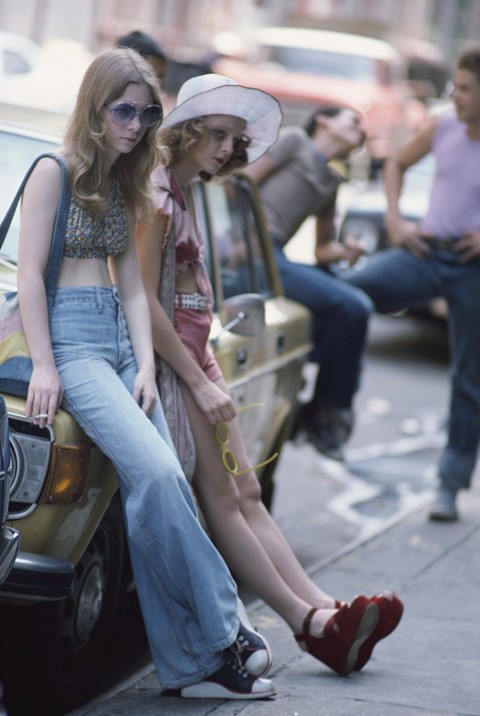
The Signature Style
Iris is a girl whose vulnerability is masked by a startling maturity and seemingly blasé approach to her circumstances (she is the antithesis of Cybill Shepherd’s naïve, squeaky clean Betsy). A pre-teen runaway, who “hates” her family, she calls out Bickle for being too “straight” when he takes her for breakfast and attempts to persuade her that selling herself at such a tender age is not what’s best for her. Her style is playful and Lolita-esque; part adult, part child. A wide brimmed straw hat, an oversized cotton shoulder bag, a variety of brightly coloured sunglasses and a pair of crimson velvet platform sandals make up her signature accessories. These are accompanied by hotpants or bell-bottomed trousers, in red, blue or an ironically pure white, and a variety of crop tops – most notably the pale pink, tie-front shirt with burgundy flowers – that reveal her slender, barely adolescent figure. A silver-studded, white belt adorns her waist like a redundant chastity belt, while a childish, three-heart necklace skims her collarbone.
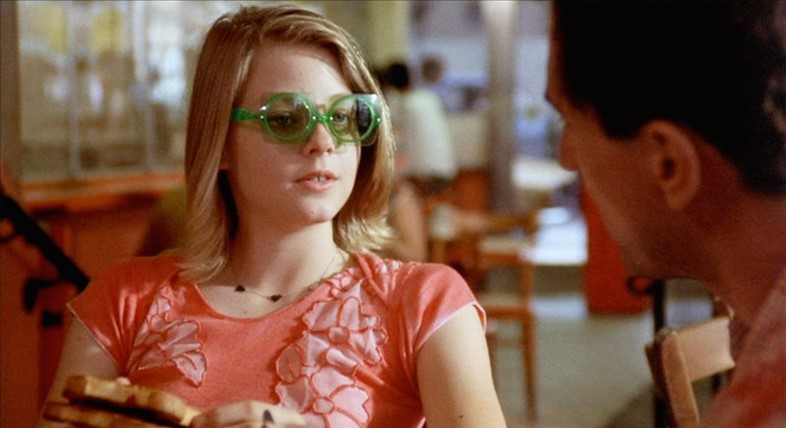
The first two times we encounter Iris, she’s on the job, wearing her shoulder-length hair in coiffed ringlets and hiding behind dinner plate sized sunglasses. When she meets Bickle in the diner however, she wears her hair straight, appearing instantly younger, and dons a pair of alien green, square-lensed sunglasses, which she switches for navy-tinted oval frames halfway through her breakfast of jam on toast with sugar on top. It is in this, less disguised state that Bickle finally succeeds in planting a seed of doubt in her mind as to slimy pimp Sport’s intentions.
Interestingly Iris’s clothing choices as well as her walk, mannerisms and fondness for sugar on toast, were all borrowed from Garth Avery, an underage prostitute whom scriptwriter Schrader met while researching for the film. After their encounter, where he himself took Avery for breakfast, Schrader changed much of the dialogue in the now-iconic diner scene to imitate Avery’s turn of phrase. Avery makes a cameo in the film as the fellow hooker who accompanies Foster down the street when Bickle approaches her for the first time.
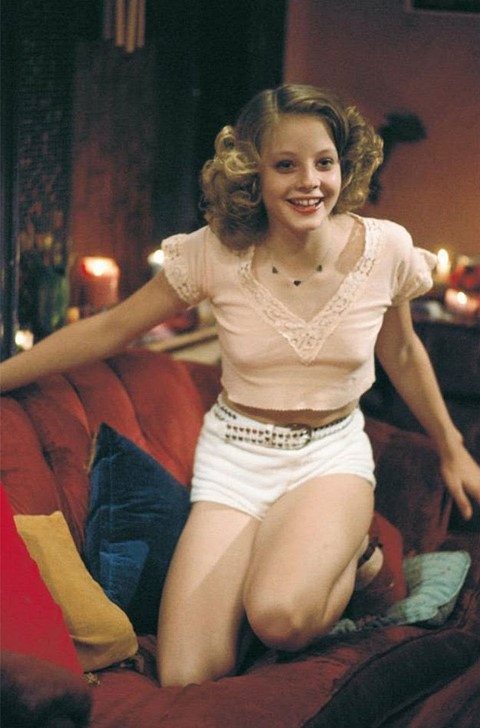
The Modern Manifestation
With fashion’s bout of 70s nostalgia still going strong, Iris’s style remains as covetable now as ever before. Gucci is a good place to turn for those looking to interpret the heroine’s strong sartorial choices today: Alessandro Michele’s fondness for soft pinks, frequently paired with deep reds, channel Steensma’s chosen colour palette, while floral prints exist in happy abundance. To complete the look, a penchant for the excessive is key: shorts must be miniscule, flares expansive, sunglasses as big, bright and bold as your heart desires, sun hats, large brimmed (and turned upwards). Until she is finally rescued, Iris’s life is spent being forced to succumb to other people’s desires. Her dress sense is her only means of self-expression, and an attempt at self-preservation, in a harsh, male dominated world – and that in itself deserves to be celebrated.
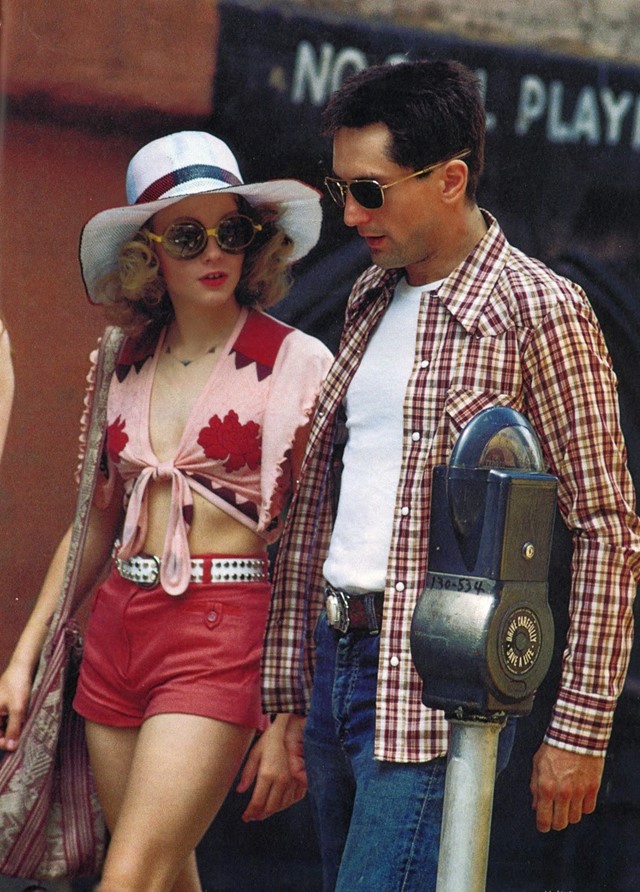
Taxi Driver is released on February 10 as part of the BFI’s Martin Scorsese Season.
